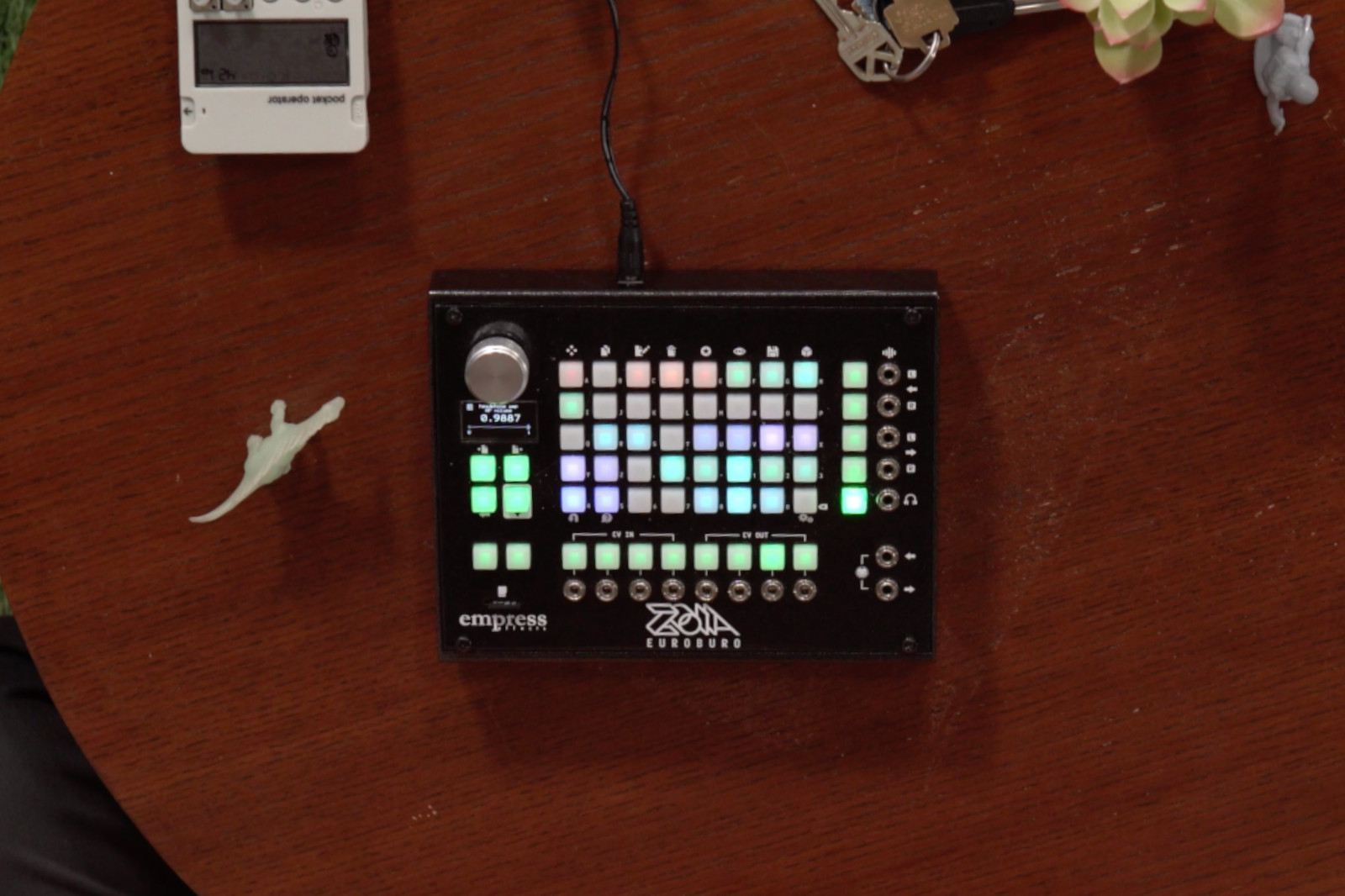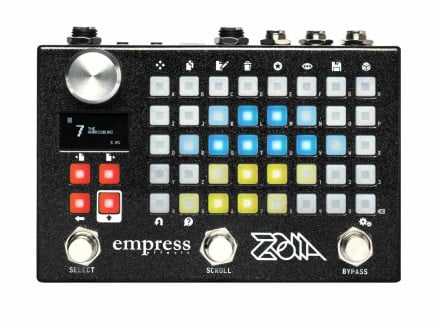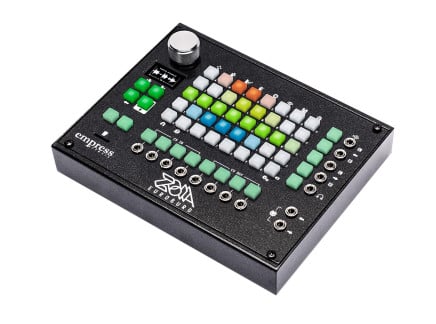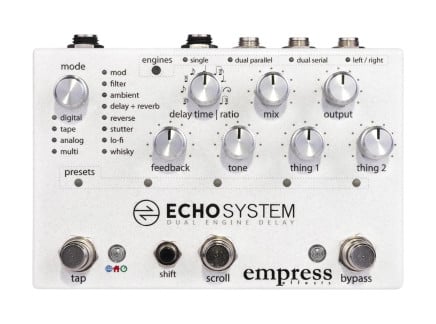These days, the capabilities of guitar and effects pedals are rather incredible. Not only are the quality of some effects themselves on par with professional studio gear and plug-ins, the flexibility and uniqueness of pedals that are available today is continually inspiring. But few have really challenged the idea of what a pedal can do like the Empress Effects ZOIA. It's an effects processor, synthesizer, and utility for MIDI and CV manipulation rolled into one box, with a modular workflow which means that what it does at any given moment is totally arbitrary and defined by the user.
Whether you prefer the original pedal version or the modular-ready Euroburo, we at Perfect Circuit think that ZOIA has something to offer for everyone. And because ZOIA itself is totally open-ended, patches can be as simple or complex as necessary, and either way is an entirely valid approach to using it. If you're new to ZOIA or looking for other perspectives to inspire your patches, check out our Patch Pals video above, and keep reading for further details on how Wes and I are using ZOIA.
What is ZOIA?
To quote Empress directly, "ZOIA is basically a modular synthesizer in pedal form." This means that ZOIA's functionality is built through connecting virtual modules together, making it capable of unique sounds and utility functionality that might otherwise be achieved with multiple traditional pedals. If you have a background with hardware like Eurorack systems or software such as Max/MSP and Pure Data, ZOIA's workflow might feel familiar to you. Otherwise, it might be helpful to think of ZOIA like a sort digital pedalboard and effects sandbox where you can dream up any combination of effects, synthesis functions, and much more.

The ZOIA platform is found in two different forms: the classic pedal version and the Euroburo module for Eurorack modular synthesizers. Aside from the slight differences in layout, the experience of using ZOIA is exactly the same on both. Patches exist as pages of modules on a 8x5 grid of buttons with RGB LEDs. Tap an unlit button to place a module, or touch on any part of an existing module to display parameter information on the screen. Connections are made by holding down a button on one module and pressing a corresponding input or output button on another—it's really that easy, with seemingly no limit on the number of connections that can be made. All versions of ZOIA support stereo audio input and output, MIDI input and output, and the storage of up to 64 patches on the device itself—which may be saved and swapped out with a microSD card.
At the time of writing, ZOIA features well over 80 different types of modules, ranging from pre-built effects like phasers and reverb to synthesis building blocks such as oscillators, envelope generators, and filters. There's also a thorough collection of interfacing elements, both for navigating and supplying visual feedback to the button grid as well as accessing the ports for audio and MIDI connections, plus stompswitches, expression and CV, and more.
In our eyes, this wide range of flexibility makes the ZOIA experience twofold. On one hand, the higher-level modules make it really easy to build just about any variation on a traditional effect imaginable. Maybe you want a stereo delay with pitch-shifting and granularization in the feedback path, or an interactive chorus with depth and intensity that responds to the dynamics of your playing—these are two examples of things that are fairly easy to achieve on the ZOIA. But on the other hand, the lower-level modules that are available allow you to build your own processing blocks from the ground up, to a degree which might only be surpassed by learning to code or build circuits yourself.
Jacob's ZOIA Patches: Unlocking Your Pedalboard
For me, a virtual modular paradigm like ZOIA is the perfect way to inject some nonlinearity and interactivity into my pedalboard. While I appreciate the conveniences afforded by a fixed configuration and signal path, my time spent with Eurorack and other modular synthesizer format spoiled me with their inherent routing flexibility and ease of audio or control signal distribution. ZOIA lets me draw from this past experience in the context of a pedalboard, whether its through creating and modulating effects with envelope followers and pitch detectors or spewing out sequences or random control data as MIDI messages to control other pedals.
One thing that's particularly noteworthy about my ZOIA usage is that I'm not using it for stereo effects, but rather as a two-stage, dual mono processor. I use one pair of I/O channels as the very first thing in my pedal chain—offering me a totally dry, unaffected guitar signal that I find works best for envelope followers and pitch detection. From there, I run out through a few other pedals (mainly drives and compressors) before coming back into ZOIA's other input, and it's here where I'll do some amount of effects processing. When I'm playing away from the computer, where I have an abundance of guitar amp plugins, I'll always at least throw on ZOIA's cab simulator module here to give my guitar tone that amp-like sound.
For my first patch in our ZOIA video, I keep things fairly simple. Because I have other powerful pedals like Strymon's BigSky and Eventide's H9 on my board, I can keep my ZOIA patches straightforward and focused on the more unique things that it can do compared to my other pedals. With those other pedals assigned to building ambient, swelling pads, I can use ZOIA's pitch detector module in tandem with oscillators for a synthesized lead line which follows my guitar playing.

ZOIA's control capabilities aren't limited to being contained within itself, and can easily translate its internal signals MIDI messages and control voltages to control external gear. With how flexible the H9 is, it's truly cracked open when paired with something like the ZOIA that can so easily and immediately bombard it with MIDI data. One basic idea is using ZOIA's onset detector to trigger random program changes, unpredictably recalling different H9 presets for ever-changing and chaotic sounds.
But for a more controlled and musical example, as seen in the video, I set up a handful of ZOIA sequencers to transmit MIDI control change messages to the H9 while operating in the Resonator algorithm. Everytime the sequencer advances, the updated CCs retune each of the four resonator voices to a different chord. I show two examples of how this can be controlled: manually with a footswitch, or automatically with an LFO or clock, with its rate controlled by an expression pedal.
Wes' ZOIA Euroburo Patches: Swiss Army Knife and Problem Solver
For Wes, ZOIA's Euroburo form is the perfect complement to a number of his favorite modules, extending and supplementing their capabilities on a per-patch basis. While he's rocking a system already packed with feature-rich modules like Pamela's NEW Workout, Maths, and Voltage Block, even these very versatile tools are more focused in their functionality than ZOIA. By pairing ZOIA with a subset of modules that are already very good at a handful of things, it makes it easier to lean on ZOIA for functionality that's either entirely missing from the system, or picking up slack when other modules are tied up with other tasks.
Take his tutorial patch in our video as an example of a very practical way to use ZOIA with this mindset. ZOIA's own modular nature means that it's easy to whip up parallel chains of audio and control voltage processing—all functioning as independently or interconnected as you'd like them to be. Specifically, Wes makes use of ZOIA's quantizer to craft arpeggios from an external LFO, then separately routes the Chainsaw through ZOIA and applies the ethereal Ghostverb module for added space and dimension. Other ZOIA modules like the Granular processor and Audio Buffer have become favorites for Wes, offering their own vibe and definable nature in a different way from dedicated sampling and granular modules out there. Being able to call upon these whenever they're needed is a big reason for the value that Wes sees in having the Euroburo in his system.
But like the pedal version, the ZOIA Euroburo can go anywhere once installed in its nifty companion desktop case, evolving from a Eurorack module to a standalone powerhouse processing unit. At home, Wes might like to pair it with instruments like the Softpop II and PO-12, but as seen in the video above it's great for pulling your Euroburo out of the rack and bringing it along to a jam with some friends. Whether its crunching up a drum machine or building out noisy textures for an ambient track—ZOIA is as flexible as you need it to be.
The World is Your ZOI-ster
Since its release in 2019, ZOIA has been adopted by many curious minds hoping to turn their pedalboard or Eurorack system on its head. Empress has also been diligently putting out periodic firmware updates, with new features, modules, and workflow improvements to continue extending its functionality. Add in the online communities built around sharing patches and learning the ins and outs of this capable little friend, and you'll find no shortage of things that ZOIA can do, even if you never dive into crafting patches yourself—even though we definitely think you should!
But at the end of the day, there's still one point that we always like to emphasize with ZOIA or any other open-ended platform: it's totally okay to use ZOIA for simple tasks. Establishing some basic duties and then being able to build up a personal library of patches for yourself is one of many ways to get the full value out of ZOIA. And while it's easy to feel like you have to completely maximize its capabilities at every waking moment, remember that finding that unique and niche use case that's only really possible due to ZOIA's modular nature just might make it the solution you've been looking for.












